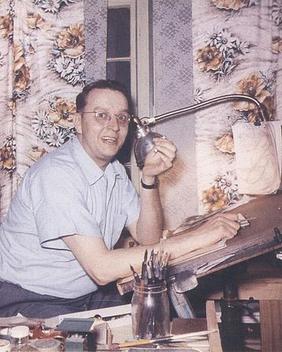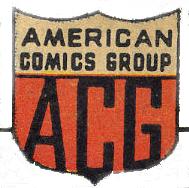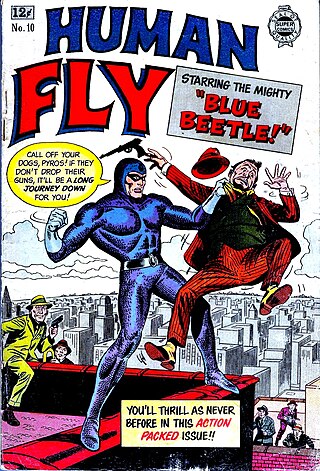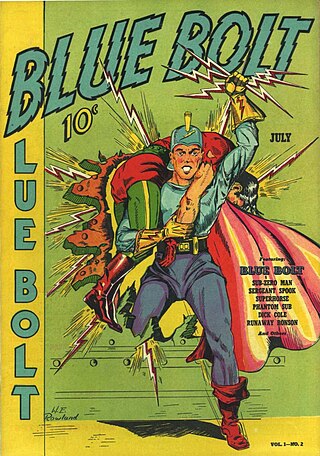
Jack Ralph Cole was an American cartoonist best known for birthing the comedic superhero Plastic Man, and his cartoons for Playboy magazine.

Joseph Henry Simon was an American comic book writer, artist, editor, and publisher. Simon created or co-created many important characters in the 1930s–1940s Golden Age of Comic Books and served as the first editor of Timely Comics, the company that would evolve into Marvel Comics.
Black Fury is the name of several fictional comic book characters published in the Golden Age of Comics.

American Comics Group (ACG) was an American comic book publisher started in 1939 and existing under the ACG name from 1943 to 1967. It published the medium's first ongoing horror-comics title, Adventures into the Unknown. ACG's best-known character was the 1960s satirical-humor hero Herbie Popnecker, who starred for a time in Forbidden Worlds. Herbie would later get his own title and be turned into a "superhero" called the Fat Fury.
United Feature Syndicate, Inc. (UFS) is a large American editorial column and comic strip newspaper syndication service based in the United States and established in 1919. Originally part of E. W. Scripps Company, it was part of United Media from 1978 to 2011, and is now a division of Andrews McMeel Syndication. United Features has syndicated many notable comic strips, including Peanuts, Garfield, Li'l Abner, Dilbert, Nancy, and Marmaduke.

The Funnies is the name of two American publications from Dell Publishing, the first of these a seminal 1920s precursor of comic books, and the second a standard 1930s comic book.
Fox Feature Syndicate was a comic book publisher from early in the period known to fans and historians as the Golden Age of Comic Books. Founded by entrepreneur Victor S. Fox, it produced such titles as Blue Beetle, Fantastic Comics and Mystery Men Comics.

I.W. Publications was a short-lived comic book publisher in the late 1950s and early 1960s. The company was part of I.W. Enterprises, and named for the company's owner, Israel Waldman. I.W. Publications was notable for publishing unauthorized reprints of other publishers' properties. Usually these companies were already out of business.
Leonard Brandt Cole, commonly known as L. B. Cole, was a comic book artist, editor, and publisher who worked during the Golden Age of Comic Books, producing work in various genres. Cole was particularly known for his bold covers, featuring what he referred to as "poster colors"—the use of primary colors often over black backgrounds. In addition to his covers, Cole did interior art for comics published by Holyoke Publications, Gilberton, and Ajax/Farrell. He also worked as an editor for Holyoke in the 1940s.

Lady Luck is an American comic-strip and comic-book crime fighter and adventuress created and designed in 1940 by Will Eisner with artist Chuck Mazoujian. She starred in a namesake, four-page weekly feature published in a Sunday newspaper comics insert colloquially called "The Spirit Section", which ran from June 2, 1940, to November 3, 1946. Her adventures were reprinted in comic books published by Quality Comics. A revamped version of the character debuted in 2013 in DC Comics's Phantom Stranger comic.

Reg'lar Fellers is a long-running newspaper comic strip adapted into a feature film, a radio series on the NBC Red Network, and two animated cartoons. Created by Gene Byrnes (1889–1974), the comic strip offered a humorous look at a gang of suburban children. Syndicated from 1917 to January 18, 1949, Byrnes' strip was collected into several books. Branding also extended to such items as baseball bats and breakfast cereal.
The Holyoke Publishing Company was an American magazine and comic-book publisher with offices in Holyoke, and Springfield, Massachusetts, and New York City, Its best-known comics characters were Blue Beetle and the superhero duo Cat-Man and Kitten, all inherited from defunct former clients of Holyoke's printing business.

Magazine Enterprises was an American comic book company lasting from 1943 to 1958, which published primarily Western, humor, crime, adventure, and children's comics, with virtually no superheroes. It was founded by Vin Sullivan, an editor at Columbia Comics and before that the editor at National Allied Publications, the future DC Comics.

Rulah, Jungle Goddess is a fictional character, a jungle girl, in comic books published by Fox Feature Syndicate. She first appeared in Zoot Comics #7. Matt Baker designed her, before Jack Kamen and Graham Ingels helped develop her image.

Blue Bolt is a fictional American comic book superhero created by writer-artist Joe Simon in 1940, during the period fans and historians refer to as the Golden Age of Comic Books.
Novelty Press was an American Golden Age comic-book publisher that operated from 1940 to 1949. It was the comic book imprint of Curtis Publishing Company, publisher of The Saturday Evening Post. Among Novelty's best-known and longest-running titles were the companion titles Blue Bolt and Target Comics.
Richard Briefer was an American comic-book artist best known for his various adaptations, including humorous ones, of the Frankenstein monster. Under the pseudonym Dick Hamilton, he also created the superhero team the Target and the Targeteers for Novelty Press.

Star Publications, Inc. was a Golden Age American comic book publisher, operating during the years 1949–1954. Founded by artist/editor L. B. Cole and lawyer Gerhard Kramer, Star specialized in horror, crime, and romance comics — but also published funny animal stories. Star was originally based in New York City before relocating to Buffalo, New York.
Jack Schiff was an American comic book writer and editor best known for his work editing various Batman comic book series for DC Comics from 1942 to 1964. He was the co-creator of Starman, Tommy Tomorrow, and the Wyoming Kid.
Henry C. Kiefer was an American artist from the Golden Age of Comic Books. Best remembered for his contributions to the long-running comic book series Classics Illustrated, Kiefer was a prolific artist who drew features for just about every publisher of his era.











